Fractal forms—complex shapes which look more or less the same at a wide variety of scale factors, are everywhere in nature. From the fluctuations in the cosmic microwave background radiation to the coastlines of continents, courses of rivers, clouds in the sky, branches of plants and veins in their leaves, blood vessels in the lung, and the shape of seashells and snowflakes, these fractal or self-similar patterns abound. The self-similarity of most of these patterns is defined only in a statistical sense: while the general “roughness” is about the same at different scales, you can't extract a segment, blow it up, and find a larger scale segment which it matches precisely.
However, some of the most pleasing patterns in geometric art exhibit exact or almost exact self-similarity. These are patterns which are composed of smaller copies of themselves ad infinitum, or at least until some limit where the similarity breaks down due to the granularity of the underlying material.
| Romanesco Taxonomy | |
|---|---|
| Domain | Eukaryota |
| Kingdom | Plantæ |
| Division | Magnoliophyta |
| Class | Magnoliopsida |
| Order | Brassicales |
| Family | Brassicaceæ |
| Genus | Brassica |
| Species | oleracea |
| Cultivar | Botrytis Group |
Nearly exact self-similar fractal forms occur do in nature, but I'd never seen such a beautiful and perfect example until, some time after moving to Switzerland, I came across a chou Romanesco like the one above in a grocery store. This is so visually stunning an object that on first encounter it's hard to imagine you're looking at a garden vegetable rather than an alien artefact created with molecular nanotechnology. But of course, then you realise that vegetables are created with molecular nanotechnology, albeit the product of earthly evolution, not extraterrestrial engineering.
Perhaps it's in part due to how alien this vegetable appears that there's so little consensus as to what it should be called. Romanesco (as I'll refer to it henceforth) is a member of the species Brassica oleracea L., which includes cabbage, broccoli, Brussels sprouts, cauliflower, collard greens, kohlrabi, and numerous other “cultivars” (cultivated variations). Plant species are broader and more diverse than those of animals. All of these plants, notwithstanding their gross morphological differences, can and have been crossed, resulting in such innovations as broccolini (a cross of Chinese kale and broccoli) and broccoflower (a cross of broccoli and cauliflower which superficially resembles Romanesco but lacks its near perfect self-similar fractal form). I wonder what you'd get if you crossed red cabbage with Romanesco? Hmmm….
The French name, chou Romanesco literally
translates to “Romanesco cabbage”, placing it in the cabbage family
even though it doesn't much resemble any cabbage you've ever seen.
In German, it's Pyramidenblumenkohl: “pyramid
cauliflower”; in Italy, where it was first described in the sixteenth
century, it's called broccolo romanesco:
“Romanesco broccoli”, but sometimes cavolo
romanesco: “Romanesco cabbage”. Finally, in English it's usually
called “Romanesco broccoli”, but you'll also see it referred to as
“Romanesco cauliflower”. Even professional plant taxonomists can't
decide precisely where it belongs; some place it within the
Italica group with broccoli,
while others argue
it belongs in the Botrytis group with cauliflower.
Broccoli, cabbage, cauliflower—beats me—let's just consider
it sui generis and call it “Romanesco”.
These natural fractal patterns, of great apparent complexity, can be simulated by simple computer programs such as our Terranova, its companion Terranova Screen Saver, and Cellular Automata Laboratory, producing results which mimic those in nature. This tempts one to speculate that nature generates these patterns through a process akin to computation.
It seems like the universe just wants to compute. Of course, there's a tendency for thinkers in every age to model the universe in terms of the predominant technology of the day. To the Pythagoreans, all was number and geometry. In Newton's time, the universe seemed an intricate clockwork mechanism. Later, in the age of steam, thermodynamics and heat death dominated models of the universe. Today, surrounded by computers evolving more rapidly than anything in natural history, what could be more natural than regarding the universe as a great automaton performing some kind of cosmic computation?
And yet, there may be some truth in that viewpoint, and insights to be had by pursuing it, just as earlier worldviews provided frameworks for further discoveries. Stephen Wolfram's A New Kind of Science and Rudy Rucker's forthcoming The Lifebox, the Seashell, and the Soul (excerpt) argue that many of the processes we see in nature are indeed computations.
Wolfram finds that, essentially regardless of details, the results of iterated computations fall into four general (although not entirely exclusive) classes. Class 1 computations produce uniform results from almost any input. Class 2 computations produce output which depends upon the input, but the results either stay the same forever or repeat with a short cycle time. Class 3 computations produce output which appears random (and often passes stringent tests of randomness), while Class 4 computations balance on the edge of order (Class 2) and chaos (Class 3), manifesting localised structures which move and interact with one another in complicated ways. Starting a one-dimensional cellular automaton with random input and various rules demonstrates the behaviour of the four classes of computation.
Class 1: Rule 250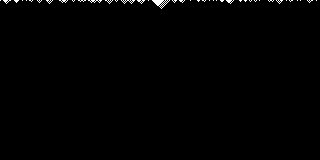
|
Class 2: Rule 132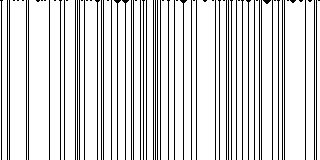
|
Class 3: Rule 122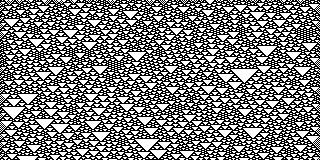
|
Class 4: Rule 110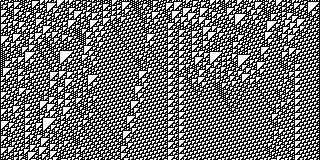
|
Many Class 3 computations produce self-similar or fractal output, which Wolfram refers to as “nested”. The image below is produced by a computer program eight bits in length—the number 126—interpreted to define the new state of a cell based on its current state and those of its two immediate neighbours. The program is started on the the top line of the image, which consists of a single black cell in the middle of the line. Subsequent lines show the evolution as the program is applied over and over, each line serving as input to the line below it.
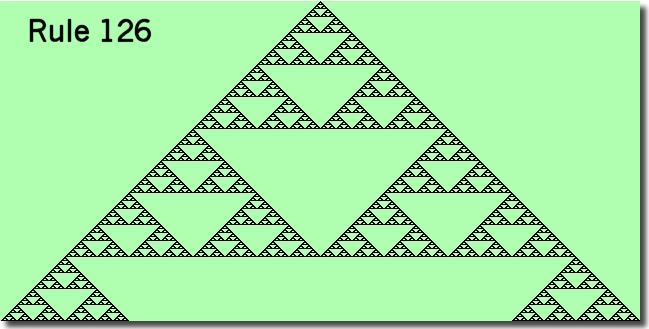
The structure produced by this rule was named the “Sierpiński Gasket” by Benoit Mandelbrot; the same pattern appears in Pascal's triangle of binomial coefficients. Note the intricate nesting of the white triangles; in this small image, eight levels of nesting are present (counting the partial triangle at the bottom). Extrapolated to infinity, an infinite number of nesting levels will be present. Heck of a lot to get from a computer program you can write down as a three digit decimal number, don't you think? Even though this is a simple two dimensional pattern produced by a one dimensional computation, the similarity with the three dimensional hierarchical structure of the Romanesco is compelling.
These photos were all taken with a Nikon D70 digital camera. The photo above of the entire Romanesco was taken with a NIKKOR AF 28–80 mm zoom lens at 44 mm (note that due to the size of the image sensor in the D70, focal lengths should be multiplied by a factor of 1.5 for the 35 mm film camera equivalent). Lighting was a mix of natural and overhead fluorescent light, arranged (not entirely successfully) to minimise shadows. Exposure was ½ second at f/29.
The close-up photos were all taken with a vintage Micro-NIKKOR 55 mm f/2.8 manual focus macro lens, stopped down to the minimum aperture of f/32 to maximise depth of field; at f/32, the hyperfocal distance is such that everything from the closest point at which the lens can focus to more than four metres is effectively in focus. The first photo below was taken with the macro lens mounted directly on the camera body with a 4 second exposure time, while the balance of the photos used a Nikon PK-12 14 mm extension tube between the camera and lens to permit focusing even closer than the minimum 25 cm object to image plane distance of the macro lens alone. With the macro lens and extension tube, it's possible to focus as closely as 21 cm object to image plane, at which point the front of the lens barrel is only about 7 cm from the object. The extreme close-ups taken with the extension tube required an exposure of 13 seconds at f/32. Fortunately, as photographic subjects, vegetables, even fractal ones, aren't nearly as fractious as supermodels or cows, so such long exposure times pose no difficulty as long as the camera is mounted on a sturdy tripod. All of the close-ups were lit entirely by overhead fluorescent lights.
Images were postprocessed with The Gimp on Linux. Postprocessing amounted to cropping, modest sharpening, and adjusting the colour balance to approximate the actual colour of the vegetable as perceived by the human eye under natural light. When you shoot a photo like the close-ups where the entire field of view is a uniform hue like green, the automatic white balance in the camera will shift the white point to try to adjust the picture toward the white. It's best to disable the automatic white balance entirely, but if you forget to (as I did when taking these shots), it's easy enough to correct after the fact. Yes, a Romanesco is actually the radioactive green colour shown in these pictures. The leaves are a darker blue green typical of broccoli or cauliflower. When cooked, the colour lightens to a less saturated greenish white.
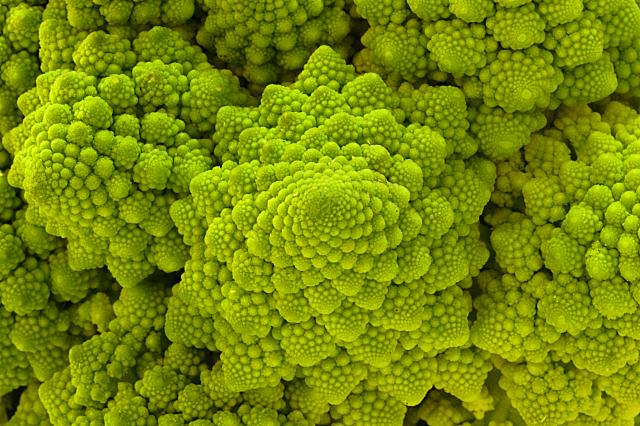
Every self-similar pattern in nature breaks down at some scale—at the level of molecules and atoms if not before. The last photo shows the tiny structures near the top level spiral. As the spirals get smaller and smaller approaching the vertex, the spirals that make them up have less and less lower level detail, with the tiniest being little more than bumpy spheroids.
Romanesco is excellent raw, enhancing both the appearance and taste of an assiette de crudités. It's crunchier than cauliflower and not as bland. It has a nutty taste (and looks kind of nutty too until you get used to it!) and doesn't have the chalky edge which some people dislike in broccoli. Any dip that's good with cauliflower and broccoli will go fine with Romanesco, but be sure to try it by itself—you may decide to forgo the dip. It would be absolutely ideal to serve raw Romanesco on a platter with an image of the Mandelbrot set!
Romanesco can be cooked using any method that's suitable for broccoli or cauliflower, and may be substituted in any recipe which calls for them. My personal favourite way to prepare it it to break off the “level 1” spirals (it's easier to do this with the ones at the base if you first cut them loose from the central stem by running a short knife around it from the bottom), then steam them for between 15–25 minutes depending on how crunchy you like your vegetables. Steaming preserves far more of the vitamins in vegetables than boiling, and doesn't tend to reduce their colour to a uniform grey.
If you're counting calories, figure 34 (kilo)calories (134 kilojoules) per 100 grams of Romanesco, almost precisely the same as broccoli and cauliflower; note that there are as many calories in a single pat of butter! Romanesco is rich in Vitamin C, folic acid, potassium, and fibre. A typical Romanesco weighs between 300 and 600 grams.
You can download the program used to create the cellular automata images which appear in this page. This Perl program produces portable bitmap images which you can postprocess with the Netpbm image processing toolkit. This program is in the public domain; you can use it in any way you wish without restrictions, but it is utterly unsupported—you are entirely on your own.
|
|